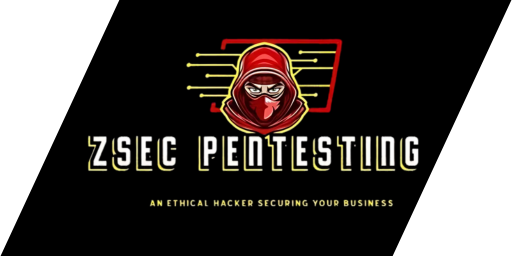
ZSec Pentesting Services
At ZSec Pentesting, we provide top-tier bug bounty hunting and penetration testing services to secure online businesses from cyber threats. Our process is designed to thoroughly uncover vulnerabilities that hackers can exploit, ensuring your website or platform is protected. Below, we outline a full demo of our bug bounty process using an online store example : **www.cars-online-store.com.uk**. This demo will walk you through the key phases of the penetration testing process, the tools we use, the time it takes, and the results we deliver.

Founder and owner of ZSec Pentesting
Bug bounty Hunter since 2018
At ZSec Pentesting, we provide top-tier bug bounty hunting and penetration testing services to secure online businesses from cyber threats. Our process is designed to thoroughly uncover vulnerabilities that hackers can exploit, ensuring your website or platform is protected. Below, we outline a full demo of our bug bounty process using an online store example : **www.cars-online-store.com.uk**. This demo will walk you through the key phases of the penetration testing process, the tools we use, the time it takes, and the results we deliver.
The first step in the penetration testing process is reconnaissance, where we gather all possible information about the target. For **www.cars-online-store.com.uk**, we begin by performing **subdomain enumeration**. Subdomains often expose additional services and potential attack vectors that are not as protected as the main website. Using tools like :
- **Amass**
- **Sublist3r**
- **Assetfinder**
- **GAU (GetAllURLs)**
We systematically search for all subdomains related to the target. In a typical scenario, for **www.cars-online-store.com.uk**, we may discover **100 subdomains** and **URLs** like :
- **admin.cars-online-store.com.uk**
- **payment.cars-online-store.com.uk**
- **dev.cars-online-store.com.uk**
Each of these subdomains represents a potential point of vulnerability.
Time for subdomain enumeration :
This phase takes approximately **2-3 hours**, depending on the size of the website and the number of connected subdomains.
Once the subdomains and URLs are identified, we begin the **vulnerability scanning** phase. This is where we scan each subdomain and URL for known vulnerabilities. We focus on **OWASP Top 10** vulnerabilities, including :
- SQL Injection (SQLi)
- Cross-Site Scripting (XSS)
- Cross-Site Request Forgery (CSRF)
- Insecure Direct Object References (IDOR)
- Security Misconfigurations
For this phase, we use a combination of automated and manual testing tools, including :
- **BurpSuite** (for proxy-based testing and vulnerability scanning)
- **OWASP ZAP** (for scanning and reporting)
- **Nmap** (for port scanning and service enumeration)
**Example :**
Let’s say the payment subdomain (**payment.cars-online-store.com.uk**) is vulnerable to an SQL injection. Using BurpSuite, we intercept and manipulate the requests sent to the server, testing whether it allows malicious SQL code to be executed. This vulnerability could allow an attacker to access the database and extract sensitive customer information such as credit card details.
**Time for vulnerability scanning :**
This phase takes approximately **6-10 hours**, depending on the number of subdomains, complexity of the site, and identified vulnerabilities.
In this phase, we simulate real-world attacks to understand the full impact of the vulnerabilities. For example, after discovering the SQL injection on **payment.cars-online-store.com.uk**, we test its impact by attempting to extract data from the database, such as :
- Customer names
- Credit card details
- Purchase histories
In one of our previous tests, we were able to demonstrate how an attacker could retrieve the full list of customer orders along with their payment information, posing a significant risk to the business.
This phase also includes **manual testing**, which is critical for detecting complex vulnerabilities that automated tools may miss.
**Time for exploitation and impact testing :**
This phase typically takes **4-6 hours**, depending on the depth of the vulnerabilities found and the complexity of exploitation.
Once the penetration testing process is complete, we generate a comprehensive **report** that includes :
- A detailed list of vulnerabilities found (e.g., SQLi on the payment subdomain)
- Steps to reproduce each vulnerability, including screenshots and attack payloads
- The potential impact of each vulnerability on the business
- Recommended fixes to close the security gaps
The report is clear and easy to understand, even for non-technical clients, ensuring they can take immediate action to secure their platform.
**Example :**
For **www.cars-online-store.com.uk**, the report would detail how to secure the SQL injection vulnerability by using prepared statements and input validation. It would also provide guidance on how to harden the web application firewall (WAF) to block similar attacks in the future.
**Time for reporting :**
Writing the report takes approximately **3-4 hours**, and it’s delivered within **24 hours** after testing is complete.
Here is a breakdown of the time required for the entire process :
- **Subdomain Enumeration :** 2-3 hours
- **Vulnerability Scanning :** 6-10 hours
- **Exploitation and Impact Testing :** 4-6 hours
- **Reporting :** 3-4 hours
Total time for a full bug bounty hunting and penetration testing process : **15-23 hours**, usually spread over **2-3 days** to ensure thoroughness.
At ZSec Pentesting, we prioritize delivering fast, effective, and in-depth security assessments that leave no stone unturned. Whether your business is a small online store or a large platform, we ensure that every vulnerability is identified and addressed before hackers have the chance to exploit them.
Don’t wait for a breach to expose your business to significant losses—contact ZSec Pentesting today. Let’s secure your online store, protect your customer data, and safeguard your reputation.
**ZSec Pentesting—Security, Trust, and Protection.**
ZSec Pentesting
we take the security of your online business seriously. Your main domain and all associated subdomains could be the gateway hackers use to break into your entire system. We use **advanced subdomain enumeration techniques** to extract **hundreds of subdomains** from just your main domain, which is often the official website of your online store or business. What many business owners don’t realize is that **every subdomain can be vulnerable**, exposing you to the most severe security risks.
Vulnerability Scanning
Once the subdomains and URLs are identified, we begin the **vulnerability scanning** phase. This is where we scan each subdomain and URL for known vulnerabilities. We focus on **OWASP Top 10** vulnerabilities, including :
- SQL Injection (SQLi)
- Cross-Site Scripting (XSS)
- Cross-Site Request Forgery (CSRF)
- Insecure Direct Object References (IDOR)
- Security Misconfigurations


BurpSuite
for proxy-based testing and vulnerability scanning

OWASP ZAP
for scanning and reporting

Nmap
for port scanning and service enumeration
Security, Trust, and Protection
At ZSec Pentesting, we prioritize delivering fast, effective, and in-depth security assessments that leave no stone unturned. Whether your business is a small online store or a large platform, we ensure that every vulnerability is identified and addressed before hackers have the chance to exploit them
Pricing Plan
ZSec Pentesting
Don’t wait for a breach to expose your business to significant losses—contact ZSec Pentesting today. Let’s secure your online store, protect your customer data, and safeguard your reputation.
